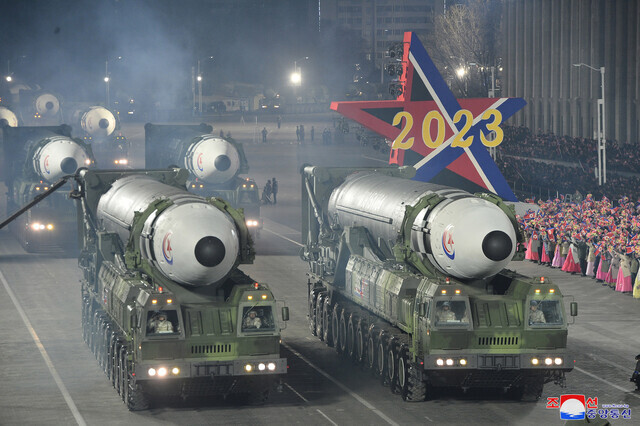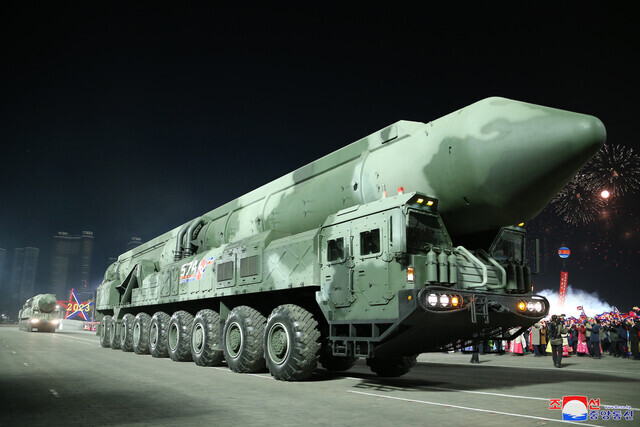hankyoreh
Links to other country sites 다른 나라 사이트 링크
N. Korea showcases massive long-range firepower in military parade

North Korea showcased tactical and long-range cruise missiles from its tactical nuclear weapon units and intercontinental ballistic missile units in a military parade celebrating the 75th anniversary of the founding of the Korean People’s Army on Wednesday night at Kim Il-sung Square in Pyongyang. According to some analysts, the missiles on display included a mockup of a new ICBM that uses solid fuel.
While North Korean leader Kim Jong-un didn’t make a speech at the parade, North Korea reconfirmed its intention of fighting “strength with strength” by parading a dozen or so Hwasong-17 ICBMs, which could hit the US, and unveiling its tactical nuclear weapon unit, which is aimed at South Korea.
According to North Korean media reports on Thursday, Kim Jong-un attended the military parade with his wife Ri Sol-ju and his daughter Kim Ju-ae.
The tactical nuclear weapon and ICBM units with their tactical missiles and long-range cruise missiles entered the square toward the end of the parade, North Korea’s state-run Korean Central News Agency reported.
The missiles were preceded by tanks of a new design, self-propelled artillery, and “super-large” multiple rocket launchers. The military parade reportedly went from 9:30 pm to 10:30 pm.
While the existence of North Korea’s tactical nuclear weapons unit was disclosed by the North Korean media in October 2022, this was the unit’s first time participating in a military parade.
“The columns of ICBMs appeared in the square [. . .], demonstrating the [. . .] tremendous nuclear strike capability of the DPRK,” the KCNA said, using the acronym for North Korea’s official name.

While the North Korean media didn’t mention the type of ICBM, the Hwasong-17 could be seen in the photos that were released. With a reported range of more than 15,000 km (9,300 miles), this missile was first unveiled in the military parade on the 75th anniversary of the establishment of North Korea’s ruling Workers’ Party, on Oct. 10, 2020.
The Hwasong-17 in that parade, which was carted in on a massive 11-axle transporter erector launcher, had an estimated length of 22 to 24 meters (72-78 feet), which would make it the longest such missile in the world. That earned it the moniker of the “monster ICBM.”
North Korea presented around a dozen Hwasong-17 ICBMs in Wednesday’s military parade as it apparently sought to imply that it has mass produced the missiles and deployed them against the US.
Last November, North Korea succeeded at separating the second stage in a launch test of the Hwasong-17, but South Korean analysts believe the missiles are not actually ready for service, given North Korea’s need to develop atmospheric reentry technology.
The Hwasong-17 was followed in the parade by four new missiles — also presumed to be ICBMs — loaded into launch tubes on mobile carriers.
“They appear to be models that will ultimately be developed into long-range missiles [ICBMs] with solid-fuel engines,” said Kim Dong-yup, a professor at the University of North Korean Studies.
Developing ICBMs with solid-fuel engines is one of five top-priority projects that North Korea is pursuing in the strategic weapons sector.
Solid-fuel missiles can be prepared for launch faster than liquid-fuel missiles, giving them a better chance of evading surveillance by South Korea and the US and of surviving South Korea’s “kill chain” strategy of pre-emptive strike.
By Kwon Hyuk-chul, staff reporter
Please direct questions or comments to [english@hani.co.kr]

Editorial・opinion
![[Editorial] Penalties for airing allegations against Korea’s first lady endanger free press [Editorial] Penalties for airing allegations against Korea’s first lady endanger free press](https://flexible.img.hani.co.kr/flexible/normal/500/300/imgdb/original/2024/0502/1817146398095106.jpg) [Editorial] Penalties for airing allegations against Korea’s first lady endanger free press
[Editorial] Penalties for airing allegations against Korea’s first lady endanger free press![[Editorial] Yoon must halt procurement of SM-3 interceptor missiles [Editorial] Yoon must halt procurement of SM-3 interceptor missiles](https://flexible.img.hani.co.kr/flexible/normal/500/300/imgdb/child/2024/0501/17145495551605_1717145495195344.jpg) [Editorial] Yoon must halt procurement of SM-3 interceptor missiles
[Editorial] Yoon must halt procurement of SM-3 interceptor missiles- [Guest essay] Maybe Korea’s rapid population decline is an opportunity, not a crisis
- [Column] Can Yoon steer diplomacy with Russia, China back on track?
- [Column] Season 2 of special prosecutor probe may be coming to Korea soon
- [Column] Park Geun-hye déjà vu in Yoon Suk-yeol
- [Editorial] New weight of N. Korea’s nuclear threats makes dialogue all the more urgent
- [Guest essay] The real reason Korea’s new right wants to dub Rhee a founding father
- [Column] ‘Choson’: Is it time we start referring to N. Korea in its own terms?
- [Editorial] Japan’s rewriting of history with Korea has gone too far
Most viewed articles
- 160% of young Koreans see no need to have kids after marriage
- 2Presidential office warns of veto in response to opposition passing special counsel probe act
- 3Months and months of overdue wages are pushing migrant workers in Korea into debt
- 4[Editorial] Penalties for airing allegations against Korea’s first lady endanger free press
- 5Japan says it’s not pressuring Naver to sell Line, but Korean insiders say otherwise
- 630th anniversary Wednesday Demonstration pushed out of memorial site by far-right
- 7OECD upgrades Korea’s growth forecast from 2.2% to 2.6%
- 8Dermatology, plastic surgery drove record medical tourism to Korea in 2023
- 9Inside the law for a special counsel probe over a Korean Marine’s death
- 10[Special reportage- part I] Attending the funeral of the victim of a South Korean war crime in Vietn